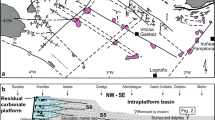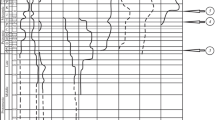Abstract
Correlation of stratigraphic sections from different continents suggests a worldwide interruption of carbonate sedimentation at the Triassic–Jurassic boundary, which coincided with one of the most catastrophic mass extinctions in the Phanerozoic. Both events are linked by a vulcanogenic maximum of carbon dioxide, which led to a temporary undersaturation of sea water with respect to aragonite and calcite and a corresponding suppression of carbonate sedimentation including non-preservation of calcareous skeletons. Besides the frequently cited climatic effect of enhanced carbon dioxide, lowering the saturation state of sea water with respect to calcium carbonate was an additional driving force of the end-Triassic mass extinction, which chiefly affected organisms with thick aragonitic or high-magnesium calcitic skeletons. Replacement of aragonite by calcite, as found in the shells of epifaunal bivalves, was an evolutionary response to this condition.


Similar content being viewed by others
References
Batten RL (1973) The vicissitudes of the gastropods during the interval of Guadalupian-Ladinian time. Canad Soc Petrol Geol Mem 2:596–607
Beerling D (2002) CO2 and the end-Triassic mass extinction. Nature 415:386–387
Blomeier D, Reijmer JG (1999) Drowning of a Lower Jurassic carbonate platform: Jbel Bou Dahar, High Atlas, Morocco. Facies 41:81–110
Carter JG (1990a) Evolutionary significance of shell microstructure in the Palaeotaxodonta, Pteriomorphia and Isofilibranchia (Bivalvia: Mollusca). In: Carter JG (ed) Skeletal biomineralisation: patterns, processes and evolutionary trends, vol I. Reinhold, New York, pp 135–296
Carter JG (1990b) Shell microstructural data for the Bivalvia. In: Carter JG (ed) Skeletal biomineralisation: patterns, processes and evolutionary trends, vol I. Reinhold, New York, pp 297–411
Furrer H (1993) Stratigraphie und Facies der Trias/Jura-Grenzschichten in den oberostalpinen Decken Graubündens. Universität Zürich, Zurich, 99 pp
Guex J, Bartolini A, Atudorei V, Taylor D (2003) Two negative δ13Corg excursions near the Triassic–Jurassic boundary in the New York Canyon area. Bull Géol Lausanne 360:1–4
Hallam A (1981) The end-Triassic bivalve mass extinction event. Palaeogeogr Palaeoclimatol Palaeoecol 35:1–44
Hallam A (2002) How catastrophic was the end-Triassic mass extinction? Lethaia 35:147–157
Hallam A, Goodfellow WD (1990) Facies and geochemical evidence bearing on the end-Triassic disappearance of the Alpine reef ecosystems. Histor Biol 4:131–138
Hallam A, Wignall PB (1997). Mass extinctions and their aftermath. Oxford Univ Press, Oxford, 320 pp
Hallam A, Wignall PB (1999) Mass extinctions and sea-level changes. Earth-Sci Rev 48:217–250
Hautmann M (2001a) Taxonomy and phylogeny of cementing Triassic Bivalves (Families Prospondylidae, Plicatulidae, Dimyidae and Ostreidae). Palaeontology 44:339–373
Hautmann M (2001b) Die Muschelfauna der Nayband-Formation (Obertrias, Nor-Rhät) des östlichen Zentraliran. Beringeria 29:1–181
Hesselbo SP, Robinson SA, Surlyk F, Piasecki S (2002) Terrestrial and marine extinction at the Triassic–Jurassic boundary synchronized with major carbon-cycle perturbation: A link to initiation of massive volcanism? Geology 30:251–254
Hillebrandt A von (1994) The Triassic/Jurassic boundary and Hettangian biostratigraphy in the area of the Utcubamba valley (northern Peru). Geobios 17:297–307
Kleypas JA, Buddemeier RW, Gattuso J-P (2001) The future of coral reefs in an age of global change. Int J Earth Sci 90:426–437
Lakew T (1990) Microfacies and cyclic sedimentation of the Upper Triassic (Rhaetian) Calcare di Zu (Southern Alps). Facies 22:187–232
McElwain JC, Beerling DJ, Woodward, FI (1999). Fossil plants and global warming at the Triassic–Jurassic Boundary. Science 285:1386–1390
McHone JG (2003). Volatile Emissions from Central Atlantic Magmatic Province basalts: mass assumptions and environmental consequences. In: Hames WE, McHone JG, Renne PR, Ruppel C (eds) The Central Atlantic Magmatic Province: insights from fragments of Pangea. Geophys Monogr Ser 136:241–254
McRoberts CA (2001) Triassic bivalves and the initial marine Mesozoic revolution: a role for predators? Geology 29:359–362
McRoberts CA, Carter JG (1994) Nacre in an early Gryphaeid bivalve (Mollusca). J Paleontol 68:1405–1408
McRoberts CA, Furrer H, Jones DS (1997) Palaeoenvironmental interpretation of a Triassic–Jurassic boundary section from western Austria based on palaeoecological and geochemical data. Palaeogeogr Palaeoclimatol Palaeoecol 136:79–95
McRoberts CA, Orchard ME, Hall R, Tozer ET, Zonneveld J-P (2001) Biochronology of the Triassic/Jurassic transition in northeast British Columbia, Canada. In: Hesselbo S (ed) IGCP 458 Triassic–Jurassic boundary events. SW England Field Workshop, Oxford, p 16
Morante R, Hallam A (1996) Organic carbon isotopic record across the Triassic–Jurassic boundary in Austria and its bearing on the cause of the mass extinction. Geology 24:391–394
Olsen PE, Shubin NH, Anders MH (1987) New early Jurassic tetrapod assemblages constrain Triassic–Jurassic tetrapod extinction event. Science 237:1025–1029
Orchard MJ, Zonneveld JP, Johns MJ, McRoberts CA, Sandy MR, Tozer ET, Carrelli GG (2001) Fossil succession and sequence stratigraphy of the Upper Triassic of Black Bear Ridge, northeast British Columbia: a GSSP prospect for the Carnian-Norian boundary. Albertiana 25:10–22
Pálfy J (2003) Volcanism of the Central Atlantic Magmatic Province as a potential driving force in the end-Triassic extinction. In: Hames WE, McHone JG, Renne PR, Ruppel C (eds) The Central Atlantic Magmatic Province: insights from fragments of Pangea. Geophys Monogr Ser 136:255–267
Pálfy J, Demény A, Haas J, Hetényi M, Orchard MJ, Vető I (2001) Carbon isotope anomaly and other geochemical changes at the Triassic–Jurassic boundary from a marine section in Hungary. Geology 29:1047–1050
Pálfy J, Smith PL, Mortensen JK (2002) Dating the end-Triassic and Early Jurassic mass extinctions, correlative large igneous provinces, and isotopic events. Geol Soc Amer, Littleton, Colorado, Special Paper no. 356, pp 523–532
Sandberg PA (1983) An oscillating trend in Phanerozoic non-skeletal carbonate mineralogy. Nature 305:19–22
Smith SV, Buddemeier RW (1992) Global change and coral reef ecosystems. Ann Rev Ecol Syst 23:89–118
Soták J (2003) High-nutrient conditions at the end of the Triassic period: the evidence of the last complex foraminifers and dasycladaceans from the Western Carpathians. In: Michalík J (ed) IGCP 458: Triassic–Jurassic boundary events. Third Field Workshop, Oxford, pp 33–34
Stanley GD (1988) The History of Early Mesozoic reef communities: a three-step process. Palaios 3:170–183
Stanley SM, Hardie LA (1998) Secular oscillations in the carbonate mineralogy of reef-building and sediment-producing organisms driven by tectonically forced shifts in seawater chemistry. Palaeogeogr Palaeoclimatol Palaeoecol 144:3–19
Stothers RB (1993) Flood basalts and extinction events. Geophys Res Lett 20:1399–1402
Végh-Neubrandt E (1982) Triassische Megalodontaceae. Entwicklung, Stratigraphie und Paläontologie. Akadémiai Kiadó, Budapest, 526 pp
Walkden G, Parker J, Kelley S (2002) A Late Triassic impact ejecta layer in southwestern Britain. Science 298:2185–2188
Ward PD, Haggart JW, Carter ES, Wilbur D, Tipper HW, Evans T (2001) Sudden productivity collapse associated with the Triassic–Jurassic boundary mass extinction. Science 292:1148–1151
Yapp CJ, Poth H (1996) Carbon isotopes in continental weathering environments and variations in ancient atmospheric CO2 pressure. Earth Planet Sci Lett 137:71–82
Acknowledgements
The manuscript benefited from comments by A. Freiwald, F.T. Fürsich, A. Hallam and J. Pálfy. A. von Hillebrandt kindly provided the photo of the T–J boundary in Peru (Fig. 1D). This paper is a contribution to the IGCP Project 458: Triassic–Jurassic boundary events.
Author information
Authors and Affiliations
Corresponding author
Rights and permissions
About this article
Cite this article
Hautmann, M. Effect of end-Triassic CO2 maximum on carbonate sedimentation and marine mass extinction. Facies 50, 257–261 (2004). https://doi.org/10.1007/s10347-004-0020-y
Received:
Accepted:
Published:
Issue Date:
DOI: https://doi.org/10.1007/s10347-004-0020-y




